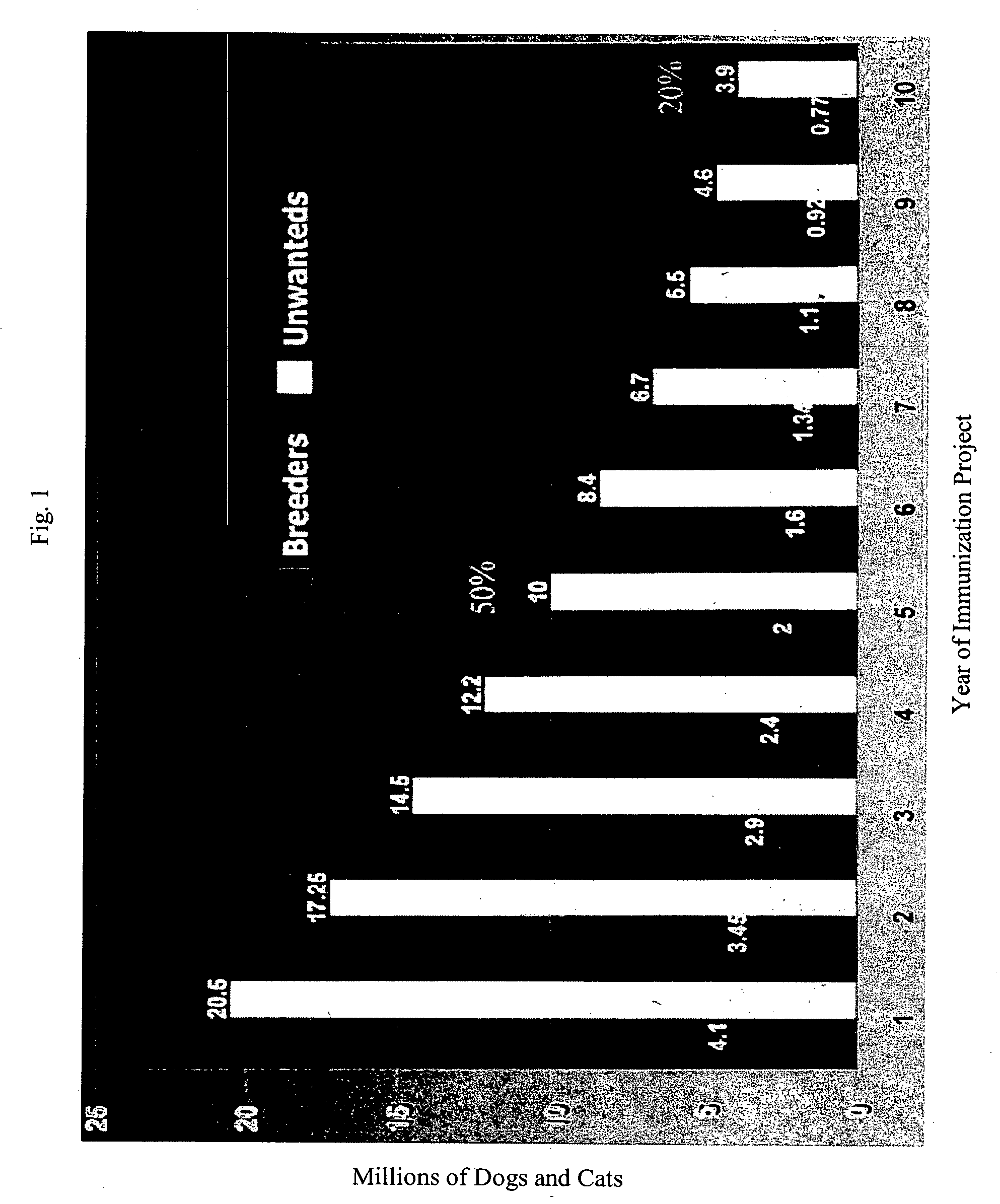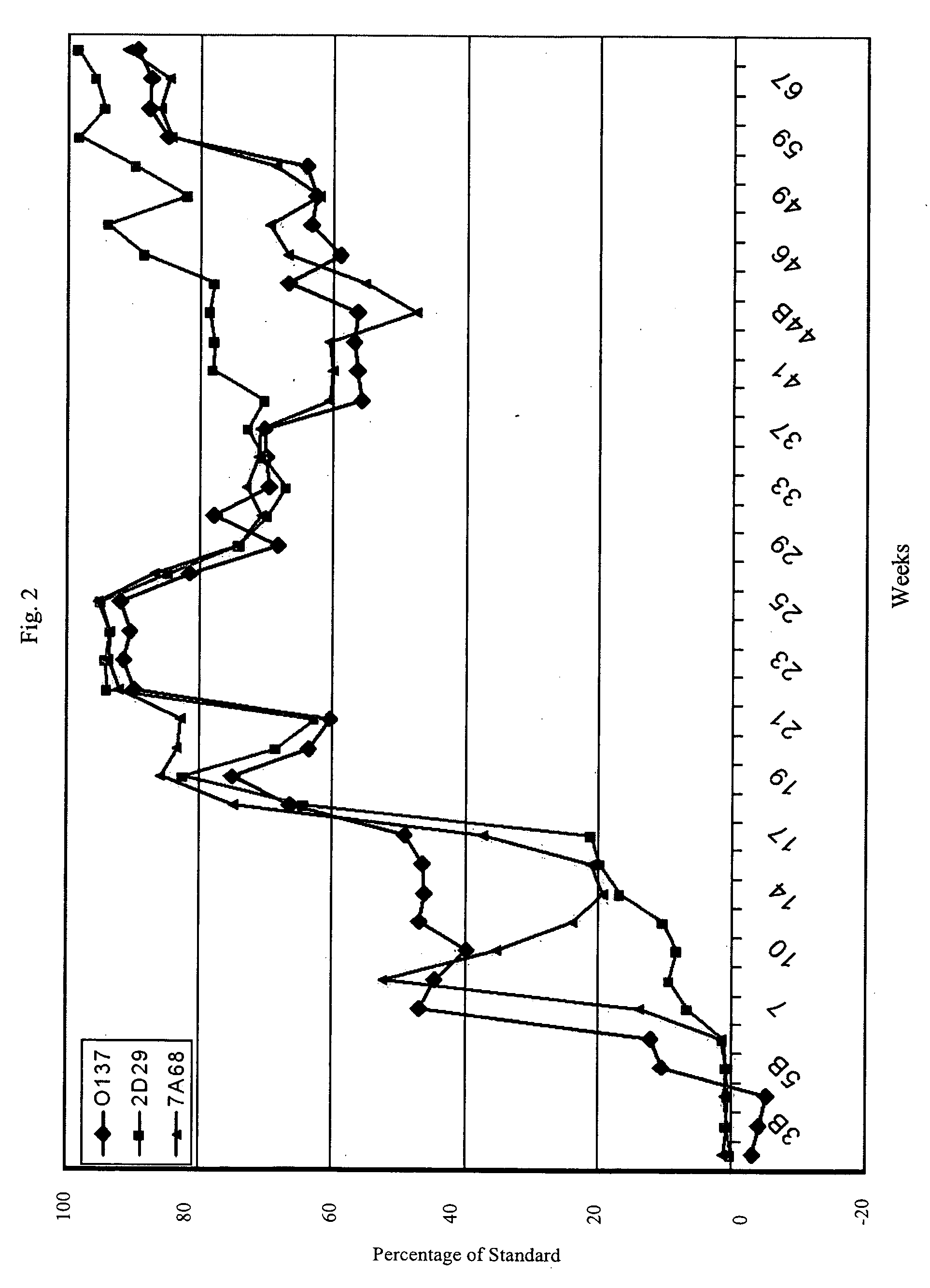Transient and/or permanent modification of sexual behavior and/or fertility using recombinant chimeric GnRH
a technology of chimeric gnrh and chimeric gnrh, which is applied in the field of transient and/or permanent modification of sexual behavior and/or fertility using chimeric gnrh, can solve the problems of enormous financial burden on the community, inability to affect any perceptible change, and high non-compliance rate, so as to improve the organoleptic properties of animals' mea
- Summary
- Abstract
- Description
- Claims
- Application Information
AI Technical Summary
Benefits of technology
Problems solved by technology
Method used
Image
Examples
example 1
Feline and Canine Responses to Anti-GnRH Antigen
[0062] We have evaluated anti-GnRH vaccines in dogs and cats using assays of reproductive hormones, anti-GnRH antibodies, reproductive behavior, fertility and histological changes in reproductive organs. A radioimmunoassay is used to assay the immunological response of dogs treated with the GnRH vaccine. GnRH labeled with radioiodine (I-125) is reacted with dilutions of sera from immunized subjects. Bovine serum albumin blocks nonspecific antigen-antibody binding. Antibody titer is defined as percentage of total radio labeled isotope bound in antibody containing sera that is precipitated with ethanol. Hormone concentrations are assayed in plasma or feces for estrone, estradiol, progesterone, and testosterone by radioimmunoassays. Male and female dogs immunized with constructs are examined for production of anti-GnRH antibodies. Female dogs are examined by vaginal cytology and plasma or fecal concentrations of estrogens and progesteron...
example 2
Feline and Canine Response to TetC Recombinant Vector
[0064] An adenovirus vectored vaccine which expresses the non-toxic tetanus toxin C fragment has been evaluated. Our first immunization trial with the Vaxin AdCMV-tetC vaccine was to confirm that it induces a vigorous immune response in cats and dogs. An additional objective was to determine the optimal route of administration. The early results of our immunization trial with the Vaxin AdCMV-tetC vaccine involved three groups of three cats each that were immunized with AdCMV-tetC by one of three routes: intranasal (IN), intramuscular (M) or subcutaneous (SQ). A non-immunized control cat in each group served as sentinel for accidental transmission of the viral vector.
[0065] Cats in all three immunization groups responded vigorously and rapidly with high anti-tetanus antibody titers (see FIGS. 8-12). The three cats in the intramuscular immunization group developed high titers (1:6,400) within 3-4 weeks after a single primary vacci...
example 3
Plasmid Construction
[0068] Plasmid pGnRH-14 consists of 13.5 GnRH repeats inserted into the NcoI site of pTrueBlue-PvuII plasmid (FIG. 23). The GnRH repeats was excised with the NcoI restriction enzyme followed by in-frame insertion into the Ncol site of pCMV-tetC encoding the tetanus toxin C-fragment (tetC) (described in Shi et al., 2001) to create a GnRH:tetC fusion sequence driven by the cytomegalovirus (CMV) early promoter (pCMV-GnRH:tetC). For pCMV-tetC, see WO 00 / 66179 and U.S. Pat. No. 6,348,450, which are herein incorporated by reference.
[0069] GnRH Nucleotide / Peptide Sequences:
5′-GAA CAT TGG TCA TAT GGA CTA CGG CCG GGA-3′E H W S Y G L R P G
PUM
| Property | Measurement | Unit |
|---|---|---|
| Composition | aaaaa | aaaaa |
| Immunogenicity | aaaaa | aaaaa |
Abstract
Description
Claims
Application Information
 Login to View More
Login to View More - R&D
- Intellectual Property
- Life Sciences
- Materials
- Tech Scout
- Unparalleled Data Quality
- Higher Quality Content
- 60% Fewer Hallucinations
Browse by: Latest US Patents, China's latest patents, Technical Efficacy Thesaurus, Application Domain, Technology Topic, Popular Technical Reports.
© 2025 PatSnap. All rights reserved.Legal|Privacy policy|Modern Slavery Act Transparency Statement|Sitemap|About US| Contact US: help@patsnap.com



